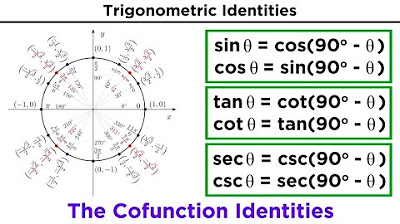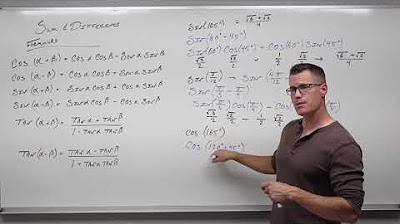Pythagorean Identities for Trigonometric Functions (Precalculus - Trigonometry 10)
TLDRThis video delves into the concepts of even and odd identities for trigonometric functions, with a focus on sine and cosine. It explains that cosine is an even function, meaning that cosine(-θ) equals cosine(θ), while sine is an odd function, leading to sine(-θ) being the negative of sine(θ). The video also covers the Pythagorean identities, which are derived from the Pythagorean theorem applied to a unit circle. These identities are crucial for simplifying trigonometric expressions and are particularly useful in calculus. The script provides a step-by-step approach to understanding and applying these identities, including how to handle angles that exceed one full rotation around the unit circle. It emphasizes the importance of mastering these identities for solving mathematical problems more efficiently.
Takeaways
- 📐 Even and odd functions: Even functions are symmetric about the y-axis, meaning f(-x) = f(x), while odd functions are symmetric about the origin, meaning f(-x) = -f(x).
- 🌀 Unit circle application: On a unit circle, cosine corresponds to the x-coordinate and sine to the y-coordinate, helping to determine the even or odd nature of these functions.
- 📈 Cosine as even: Cosine is an even function because cosine(-θ) = cosine(θ), which is evident from the symmetry on the unit circle.
- 📉 Sine as odd: Sine is an odd function because sine(-θ) = -sine(θ), which also follows from the unit circle's symmetry.
- 🔄 Secant and cosecant properties: Secant, being the reciprocal of cosine, is even, while cosecant, the reciprocal of sine, is odd.
- 🔢 Pythagorean identity: The Pythagorean identity for trigonometric functions is sin²(θ) + cos²(θ) = 1, derived from the unit circle's equation x² + y² = 1.
- ➗ Reciprocal relationships: Tangent is odd (tan(-θ) = -tan(θ)), and when relating sine to cosine (as in tangent), the odd nature prevails.
- 🔁 Periodic properties: The period of tangent is π, and for cosine and sine, it's 2π. These periods help simplify angles that exceed one rotation around the unit circle.
- ↔️ Angle manipulation: For simplifying expressions, one can use the even and odd properties of trigonometric functions to change the signs of angles and functions accordingly.
- 🧮 Power identities: The power of a trigonometric function, such as sin²(θ) or cos²(θ), is written with the power applied to the function of the angle, not the angle itself.
- 📚 Identity utility: Trigonometric identities simplify complex expressions and are particularly useful in calculus and when dealing with inverse functions.
Q & A
What does the term 'even function' refer to in the context of trigonometric functions?
-An even function, in the context of trigonometric functions, refers to a function that is symmetric about the y-axis. This means that for any angle θ, the function f(θ) will equal f(-θ), indicating that opposite inputs give equal outputs.
How does the property of odd functions graphically relate to the origin?
-Graphically, an odd function has symmetry about the origin. This means that if you rotate the graph of the function 180 degrees, or π radians, it will coincide with the original graph.
What is the relationship between sine and cosine functions in terms of their even or odd nature?
-Sine is an odd function, meaning that f(-θ) = -f(θ), while cosine is an even function, meaning that f(-θ) = f(θ). This property is useful for simplifying trigonometric expressions and understanding their behavior across different angles.
What is the significance of the Pythagorean identity for trigonometric functions?
-The Pythagorean identity for trigonometric functions, which states that sine squared θ plus cosine squared θ equals 1, is significant because it is directly derived from the Pythagorean theorem applied to a right triangle inscribed in a unit circle. This identity is fundamental for simplifying trigonometric expressions and is widely used in mathematics, physics, and engineering.
How can you determine the value of cosine for an angle that is more than one full rotation around the unit circle?
-To determine the value of cosine for an angle that is more than one full rotation, you can use the period of the cosine function, which is 2π. By dividing the angle by the period and finding the remainder, you can reduce the angle to an equivalent angle on the unit circle and then find the cosine value.
What is the relationship between secant and cosine functions in terms of their even or odd nature?
-The secant function, being the reciprocal of the cosine function, is also an even function. This means that secant of an angle θ is equal to secant of the opposite angle -θ, and changing the sign of the angle does not change the sign of the secant function's value.
How does the property of odd functions apply to the tangent function?
-The tangent function, which is the ratio of sine to cosine, is an odd function. This means that if you input an angle θ into the tangent function, you will get the negative of that value if you input the opposite angle -θ, reflecting the property that opposite inputs give opposite outputs.
What is the process of simplifying angles using the period of a trigonometric function?
-To simplify angles using the period of a trigonometric function, you multiply the period by the denominator of the angle's fraction. Then, you divide this product by the angle's numerator. The remainder from this division, when divided by the original denominator, gives you the simplified angle on the unit circle.
What are the Pythagorean identities derived from dividing the original Pythagorean identity by sine squared theta and cosine squared theta?
-When dividing the original Pythagorean identity by sine squared theta, you get 1 + cotangent squared theta = cosecant squared theta. By subtracting one or cotangent squared theta from both sides, you can derive additional identities such as cotangent squared theta = cosecant squared theta - 1. When dividing by cosine squared theta, you get tangent squared theta + 1 = secant squared theta, and by similar subtractions, you get tangent squared theta = secant squared theta - 1 and secant squared theta - tangent squared theta = 1.
How can you use trigonometric identities to simplify expressions involving different trigonometric functions of the same angle?
-You can use trigonometric identities to express all terms in the expression using a single trigonometric function of the same angle. For example, if you have sines and cosines, you can convert everything to sines and cosines, or if you have tangents, you can convert to tangents. This simplification can make the expression easier to evaluate or manipulate.
What is the practical application of understanding even and odd identities in trigonometry?
-Understanding even and odd identities in trigonometry is crucial for simplifying trigonometric expressions, especially when dealing with negative angles or angles greater than one full rotation. It also aids in the manipulation of trigonometric functions for calculus and other advanced mathematical applications.
Outlines
📚 Introduction to Trigonometric Identities
This paragraph introduces the concept of even and odd identities in trigonometric functions, focusing on the Pythagorean identities derived from the Pythagorean theorem of a right triangle inscribed in a unit circle. The explanation begins with the definitions of even and odd functions, using graphical and function-wise perspectives. It then explores the evenness of cosine and secant functions and the oddness of sine, cosecant, tangent, and cotangent functions through the examination of their behavior on a unit circle and their corresponding angles.
📈 Odd and Even Functions in Trigonometry
The paragraph delves deeper into the properties of odd and even functions in trigonometry, specifically examining the behavior of sine, cosine, and their reciprocals, secant and cosecant. It explains how opposite inputs for even functions result in equal outputs, while for odd functions, opposite inputs yield opposite outputs. The discussion continues with the effects of changing the sign of the angle on the function values and how this relates to the unit circle. The paragraph also touches on the implications of these properties for simplifying trigonometric expressions and their applications in calculus.
🔍 Exploring Pythagorean Identities
This section focuses on the derivation and application of Pythagorean identities, which are fundamental in trigonometry. It begins by establishing the relationship between the unit circle, the Pythagorean theorem, and the trigonometric functions cosine and sine. The paragraph then presents the primary Pythagorean identity, which states that the sum of the squares of sine and cosine of the same angle equals one. It also introduces corollaries of this identity, demonstrating how they can be used to simplify expressions and solve problems involving trigonometric functions.
🧩 Deriving Additional Pythagorean Identities
Building upon the initial Pythagorean identity, this paragraph explores the derivation of additional identities through algebraic manipulation. By dividing the original identity by sine squared theta and cosine squared theta, new relationships between tangent, cotangent, secant, and cosecant are established. The paragraph also discusses the corollaries that can be derived from these new identities, further emphasizing the power and utility of trigonometric identities in simplifying expressions and solving problems.
🌐 Simplifying Trigonometric Expressions
The paragraph discusses techniques for simplifying trigonometric expressions using the identities and corollaries previously introduced. It provides examples of how to handle complex angles, particularly those that involve multiple revolutions around the unit circle. The explanation includes a more advanced method for dealing with angles by using the period of the trigonometric function and finding the remainder upon division by the period. This approach is demonstrated through the simplification of various trigonometric expressions involving sine, cosine, tangent, secant, and cosecant.
📝 Applying Identities to Solve Trigonometric Problems
This section illustrates the practical application of trigonometric identities in solving problems. The paragraph guides through the process of simplifying angles and expressing trigonometric functions in terms of sine and cosine to leverage the Pythagorean identities. It emphasizes the importance of understanding the even and odd properties of trigonometric functions and the use of basic identities to simplify complex expressions. The explanation includes the step-by-step simplification of a given trigonometric expression involving secant and cosine, demonstrating the methodical approach to problem-solving using identities.
🎓 Summary of Trigonometric Identities and Problem-Solving
The final paragraph summarizes the key concepts discussed in the video script, reinforcing the importance of understanding and applying trigonometric identities. It highlights the methods for simplifying angles, the use of even and odd identities, and the power of Pythagorean identities in solving trigonometric problems. The paragraph also encourages continued practice with these concepts to gain proficiency in handling trigonometric expressions and simplifying complex problems, setting the stage for further exploration in trigonometry.
Mindmap
Keywords
💡Even and Odd Functions
💡Pythagorean Identities
💡Unit Circle
💡Trigonometric Functions
💡Secant and Cosecant
💡Tangent and Cotangent
💡Period of Trigonometric Functions
💡Sine and Cosine
💡Trigonometric Identities
💡Simplifying Trigonometric Expressions
💡Reciprocal Functions
Highlights
Introduction to even and odd identities of trigonometric functions in relation to the Pythagorean theorem on a unit circle.
Explanation of even functions as symmetrical about the y-axis, meaning opposite inputs result in equal outputs.
Odd functions are defined by symmetry about the origin, where opposite inputs yield opposite outputs.
Demonstration of cosine being an even function through examination of x-coordinates on the unit circle.
Secant is identified as an even function, similar to cosine, with the same symmetry properties.
Sine is shown to be an odd function, with y-coordinates on the unit circle exhibiting opposite outputs for opposite angles.
Cosecant is recognized as an odd function, behaving similarly to sine in terms of symmetry and output changes.
Tangent and cotangent are confirmed as odd functions, following the pattern of sine and cosecant.
Practical application of even and odd properties to simplify trigonometric expressions, such as cosine of negative angles being equal to cosine of positive angles.
Derivation of the Pythagorean identity (sin^2 theta + cos^2 theta = 1) from the unit circle equation.
Corollaries of the Pythagorean identity that allow for conversion between sine and cosine expressions.
Additional Pythagorean identities derived by dividing the original identity by (sin^2 theta) and (cos^2 theta).
Explanation of how to handle angles that exceed one rotation around the unit circle using the period of the trigonometric function.
Technique for simplifying expressions using identities, such as (tan^2 theta = sec^2 theta - 1), without relying on the unit circle.
Strategy for simplifying trigonometric expressions by first adjusting angles to fit on the unit circle and then applying appropriate identities.
Illustration of how to deal with negative angles and angles greater than a full circle using even and odd properties and the period of the function.
Emphasis on the importance of understanding and practicing with trigonometric identities to simplify complex expressions and calculations.
Transcripts
Browse More Related Video

03 - Pythagorean Trig Identities, Part 1

Basic Trigonometric Identities: Pythagorean Identities and Cofunction Identities

Ultimate trig identity problem study guide!

Introduction to Sum and Difference Formulas in Trigonometry (Precalculus - Trigonometry 25)

Inverse Trig Functions With Double Angle Formulas and Half Angle Identities - Trigonometry

Identities Grade 11: Introduction and practice
5.0 / 5 (0 votes)
Thanks for rating: